Drift Boat Fly Fishing
It was the kind of day I love to fish. I pulled with long oar strokes to cross the river’s heavy flow as the boat glided swiftly through the standing waves of the run. My goal was the shallows on the opposite bank. Here on this roadless expanse of the Henry’s Fork of the Snake River, the lush riparian growth makes that shoreline impenetrable to the wading angler.
My three sons—Jason (11), Brett (10), and Jordan (9)—were armed with some of my favorite old fly rods, and our pet Doberman, Babe, was standing guard in the bow. As we approached the far bank and I continued to slow the boat’s descent,
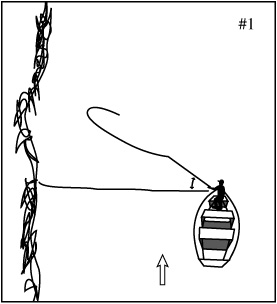
all three boys started casting their elk hair caddisflies toward rising fish. A trout quickly rose and inhaled the first offering; soon, the second fly had a trout, too. In his excitement, Jordan recast over the two struggling fish and now we had three tangled lines. Babe got into the melee by dominating the bow’s casting deck, barking loudly at the struggling fish as they leaped and fought wildly. I dropped the anchor to help with the excitement. The trout were tangled up with each other; finally I managed to release the 15 and 16 inch rainbows back into the Fork. Then, I untangled the lines. No sooner had I pulled anchor and returned to the oars than my young fly fishermen attempted to beat each other’s casts to the next good-looking lie. Soon, another trout was hooked and the tangles returned. It was a slapdash day filled with fired-up kids, dog, and trout. But it was also a perfect June day to drift
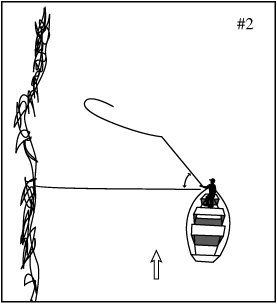
fish the Henry’s Fork.
Drift boat fishing is a splendid way to teach inexperienced fly fishermen the significance of a drag-free presentation; likewise, drift boat fishing is an almost ideal method for fishing dry flies. The bank-side fish are usually within comfortable casting distances of about 30 feet, and a drag-free float is simple to achieve if the boat is oared to match the pace of the fly. The rising trout generate excitement. Fishing with three inspired boys in the same boat, however, calls for some sort of rules.
Effective drift boat rules are as follows: (1) across-stream presentation, (2) quartering across-stream presentation, and (3) parallel casting presentation. In addition, some helpful drift boat fishing techniques will be discussed. These principles are intended to improve your success at float fishing.
The across-stream and quartering
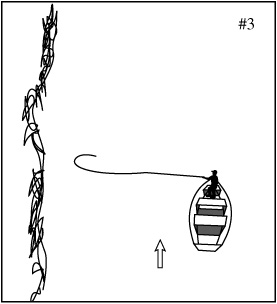
across-stream presentations clear the way for prolonged drag-free drifts with fewer entanglements. The choice of which presentation to select depends upon the speed of the drifting boat relative to the drifting fly. When the boat is moving faster than the fly, make a quartering downstream cast. This cast is made at an acute angle as measured from directly across stream. The greater the difference between boat speed and fly speed, the greater the acute angle. (See Diagrams 1&2)
On the other hand, when the boat moves slower than the fly, use the across-stream cast. This cast is made straight across the stream at a right angle. (See Diagram 3)
If the boat moves considerably slower than the fly, then the cast may need to be made quartering upstream. (See Diagram 4) All of these quartering and across-stream presentations can extend and prolong a fly’s
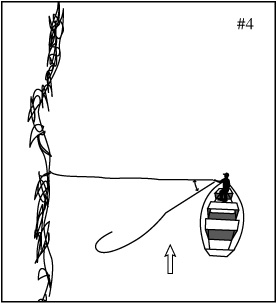
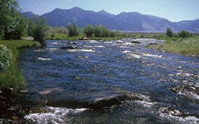
drift by compromising the cast’s position in relationship to the different boat and fly current speeds.
To prevent distress when two or more fly fishermen are casting from the same boat, parallel casting is essential. For instance, the bow and the stern anglers should cast parallel to each other. (See Diagram 5) Otherwise, dissimilar casts made at the same time will likely intersect and tangle. If the casters choose not to cast parallel, then they must alternate casting by taking turns. Of course, when the action is fast, this taking turns suffers. In general, I don’t recommend fishing three people from
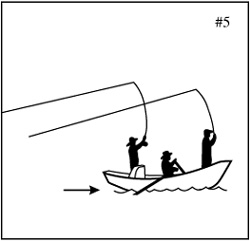
a boat but at times it’s very difficult to leave home a friend or one of your children.
If the fly fishers follow these simple casting guidelines, the oarsman can now greatly influence the fly’s potency. The oarsman must constantly observe the line and the fly’s drift, positioning the boat for accurate casting into the targeted feeding lanes. The oarsman adjusts the boat’s speed by rowing upstream or downstream in an attempt to prolong the fly’s presentation. The fly lines can be mended by changing the boat’s speed and position. An experienced oarsman can ease the fisherman’s job by improving and prolonging the fly’s presentation.
A drift boat can quickly and advantageously put you into otherwise inaccessible fish lies. A disadvantage to fishing in a drift boat is that it may only give you one cast at the area. This disadvantage is somewhat overcome by allowing you to fish a lot more water. Also, you fish to the most aggressive takers; those that

immediately strike on the first cast.
The backcast is made relatively high. A high backcast helps protect the others in the boat from a roving fly. To accomplish a high backcast make certain your forward line is straightened out before you backcast; next, aim the backcast higher than you would normally do when bank fishing. When the backcast is angled higher you must counter balance the forward cast by driving it at a lower angle. (See Diagram 6)
This casting technique is also effective in windy conditions because the angled delivery places the cast line lower to the water where the streamside vegetation has buffered the wind.
Line mending lengthens your fly’s presentation. Use common sense in deciding which direction to mend; for instance, when the boat is moving more slowly than the fly, mend in an upstream direction. Conversely; when the boat is moving faster than the fly, mend downstream. If you mend in the wrong direction the error is instantly apparent because the fly will drag badly. The mend’s purpose is to prolong a drag-free presentation, and a drag-free presentation dramatically boosts your
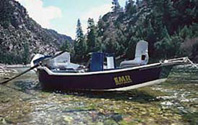
chances for success.
In drift boating, casting is used to position the fly and to dry it, while line mending and boat maneuvers direct the presentation of the fly.
The cast’s length and the boat’s distance are adjusted according to the wariness of the fish and the prevailing water conditions. Clear water and alert fish call for longer casts and greater boat distances; stained water and naïve fish, however, call for shorter casting and boat distances.
Fish holding just under the surface are less watchful and more vulnerable to a fly because their vision is restricted. Fish holding in deeper water have a larger field of vision; likewise, fish holding in deep water can more readily spot the boat. As a result, deep holding fish are more troublesome to approach than shallow holding fish.
Silence is vital for a close approach; furthermore, banging a boat bottom drives the fish away. I experienced the effect of boat noise one year when I helped with the netting of Fall Chinook Salmon on Oregon’s Chetco River. The biologists would bang the bottom of their aluminum jet sled whenever they wanted to herd the fish into the awaiting net.
It’s always a good idea to carpet aluminum boat floors with a throw rug and line the tackle trays and casting deck with rubber mats. These measures can silence a boat and allow a fly fisher a closer approach.
Be sure to avoid exaggerated casting motions. Fish are constantly on alert for birds of prey, and a false caster waiving
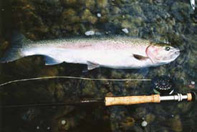
his rod arm can mimic a bird’s swooping motion. Limit the false casting to a bare minimum; if necessary, dry the fly on an absorbent cloth rather than by false casting. With a silent and a still approach, the feeding fish may be only a short cast away. A drag-free presentation dramatically boosts your chances for success.
There’s simply no doubt about it: accurate casting enhances drift boat fishing. Being able to hit a bank-side target the first time makes a great difference in productivity. Learning to negotiate underneath tree limbs by controlling line loops is also a valuable skill.
To help insure that you hit targets with your first cast, try having the appropriate length of line already stripped from your reel before you cast; this will limit the length of your cast but it will also make your cast more accurate. From trial and error adjust to find the optimal line length outside of the reel. Simply cast this line length, and, if it looks long, pull up some on the forward cast. Practice at becoming proficient at hitting the target the first time.
The ability to quickly read water is vital to successful drift boat fishing. Speed reading fish lies, of course, is a skill that only comes from experience, but even a rookie can react to an upcoming lie by recasting, repositioning or mending.
To hit each lie in pocket water requires frequent casting. Because holding lies in pocket water pass quickly, inexperienced anglers tend to panic. Instead, be patient and choose the best lies. Not even the most experienced angler can cast to every fish. In float fishing, the ability to instantly read water is a great advantage; consequently, the more miles you drift, the better you will become at reading lies and the better you will also become at communicating.
Good communication between the oarsman and the caster is essential because the oarsman is usually the first to locate the new lies. By verbally describing the
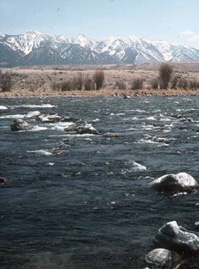
characteristics and location of downstream holding water as the boat drifts, the oarsman can assist the caster by mentally preparing the caster ahead of time to make the appropriate cast. Develop a system of communication that describes distances and clockwise locations as a basis for immediate mutual understanding. The longer you talk together the better and the quicker you will be able to understand each other. Drift boat fly fishers often use a kind of verbal shorthand to increase their success rate. For example, to alert the caster to an upcoming lie, the oarsman might use the position of the hour hand and approximate distance by calling out, “2 o’clock pocket at 30 feet” or “10 o’clock current seam at 40 feet” or something similar.
In short, drift boat fishing is a great way
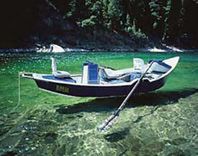
to experience a river system. We can learn of new prime lies to return to when wading or bank fishing. Drift boating reveals where and what insects are hatching on the river at a particular time. No doubt about it: it’s just plain exciting to cover lots of water and
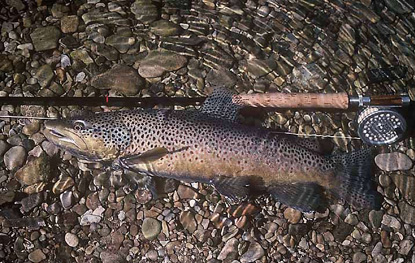

© 2026 The Gale Group, Inc. All rights reserved.
© 2026 Perigee Learning LLC. All rights reserved.
LoveTheOutdoors.com is owned and operated by Advameg, Inc. © 2026 Advameg, Inc.
Camping Adventures • Dutch Oven Cooking • Sports Knots
Fly Tying • Freshwater Fishing • Fly Fishing

